#endangeredlanguageschallenge
Explore tagged Tumblr posts
Text

First round: August 5 though 11, 2019
The purpose of the Endangered Languages Challenge is to raise awareness of endangered / moribund or recently extinct languages.
The challenge for the lingblr and langblr community is to learn and write about the languages not about their vocabulary or some interesting grammatical features.
Rules:
No exotification. We wouldn't want this to drift off into something like "this language is worth saving because it does X".
Stick to sociolinguistics. Typology and phonology are for the Linguistic Diversity Challenges.
Frequency. Post at least once a day for at least six of the seven days of the challenge.
Diversity. Try to post on languages from different families and geographical areas. Avoid eurocentrism.
Visibility. Please use the following two tags: #endangered-languages and #endangeredlanguageschallenge
Some guiding questions:
name(s) of the language What is/are the language’s name(s) for itself, the name(s) used in linguistic literature, the English name(s)?
genealogical affiliation Which linguistic family does the language belong to? Notable relatives?
location of the language Where is it spoken? Is there a diaspora community? What are its neighboring languages?
number of speakers how many speakers (native, L1) are there? how is the prognosis for future transmission to the next generation(s)?
endangerment situation Why is the language endangered? Who and what caused the language and speaker community to be marginalized or suppressed? When and why did people stop teaching it to their children? Which domains has the language been removed from? Which factors mitigate or aggravate the language’s situation nowadays? Are there media or publications in the language?
speaker community How did the speech community react to the threat and marginalization politically, artistically, socially, economically, etc.? Are there maintenance / revitalization efforts?
language breakdown Is the language still fully functional or does it show signs of structural collapse?
official / legal status Does the language have any kind of recognition, as official or minority language? Is it taught in primary to tertiary education? Is it legal to speak the language in its home country? When or where may the language (not) freely be spoken?
documentation status Is there a (sketch) grammar? A dictionary? Teaching materials? A (multimodal) corpus? Were or are there documentation efforts?
Possible ressources
http://www.language-archives.org/
http://www.unesco.org/languages-atlas/
https://glottolog.org/
http://www.glottopedia.org/index.php/Most_widely_spoken_languages
http://www.olestig.dk/endangered-languages/films.html
https://www.dnathan.com/VL/
https://aiatsis.gov.au/
http://www.endangeredlanguages.com/
https://www.ogmios.org/
http://www.endangeredlanguagefund.org/
http://gbs.uni-koeln.de/wordpress/
http://www.smo.uhi.ac.uk/saoghal/mion-chanain/en/
https://www.yourdictionary.com/elr/index.html
https://linguistlist.org/issues/16/16-2815.html
https://scholarspace.manoa.hawaii.edu/bitstream/10125/4478/hammarstrom.pdf
https://www.researchgate.net/project/endangered-languages-2
#endangered languages#sociolinguistics#endangeredlanguageschallenge#language documentation#linguistics
283 notes
·
View notes
Text
Endangered Languages Challenge, 2/7, Manchu


Names of the language:
The language is called ᠮᠠᠨᠵᡠ ᡤᡳᠰᡠᠨ (Manchu Gisun, it should be vertically written) in the language itself, 清文 or 清語 in Chinese, and Manchu in English.
Genealogical affiliation:
Manchu is a Tungusic language of the southern Manchu branch, and it is closest relation is the Jurchen language. There are also many loanwords from Mandarin and Mongolian. Location of the language:
Manchu is still spoken in the historical region of Manchuria, and was the native language of the the Manchus and one of the official languages of the Qing dynasty. Number of speakers: Although there are 10 million ethnic Manchus in China, there are only 10 native speakers of Manchu left. A 2007 census counted 18 octogenarian residents, but it has of course unfortunately decreased since then. However, thanks to free courses offered for adults by the government, there are also a few thousand L2 speakers. Endangerment situation:
Manchu is considered critically endangered by UNESCO. The EGIDS level of Manchu is 8b (nearly extinct). Throughout the 20th century, the PRC state forbid expressions of non-han ethnic cultures in an effort to completely sinicize the country, and that ban held in place until the death of Mao Zedong. Manchu is still thought of as a foreign language in a Mandarin-speaking country, and many ethnic Manchu choose to learn languages like Mongolian instead. Official/legal status:
Manchu does not hold any official status, but is recognised as an indigenous language. Documentation status:
Manchu is an incredibly important language for historians studying the Qing dynasty. Texts written in Manchu provide information not available in Chinese texts, and when Chinese contemporary texts have Manchu translations, the Manchu version often aids understanding of the Chinese. The PRC state is supporting revitalisation efforts (somewhat surprisingly) by offering free classes for adults and funding . Manchu associations can be found across the country, including in Taiwan and Hong Kong, to serve as a go-between for Manchu people and the state.
Sources Wikipedia Ethnologue More wikipedia Omniglot That one youtube channel and also they use the wrong flag
#endangeredlanguageschallenge#Manchu#Language#languages#langblr#Endangered languages#endangered languages challenge#Languages of China
126 notes
·
View notes
Photo

Endangered Languages Challenge : Paakantyi Palku
Name: Paakantyi also Barkindji; Barkandji; Paakantji; Baagandji
Genealogical Affiliation: Pama-Nyungan
Location: Far-West New South Wales, Australia (bordering on South Australia, Victoria, and Queensland). Namely Bourke; Wilcannia; Menindee; Wentworth; Broken Hill; Pooncarie

Number of Speakers: Low to mid-twenties recorded on Australian Bureau of Statistics census. More in remote communities.
Why is the language endangered? Step 2 of Process of Colonisation as outlined by Prof Virgilio Enriques: Destruction/Eradication. There is a direct link between colonisation, assimilation, and cultural genocide and the decline in native speakers of Paakantyi and its dialects.
Speaker Community: The most widespread dialect is Southern Paakantyi, the language of Pooncarie and Wilcannia. Most speakers are on either side of the Makwarra-Kilpara moiety kinship system.


There are maintenance and revitalisation efforts across all locations, most notably in Menindee, Wilcannia, Bourke, Wentworth, and Mildura. These are led by Paakantyi Elders and educators, and operate in schools, TAFE, and community groups.
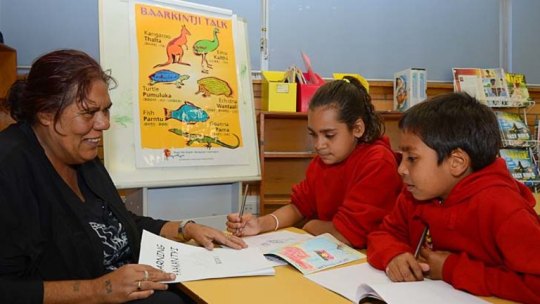
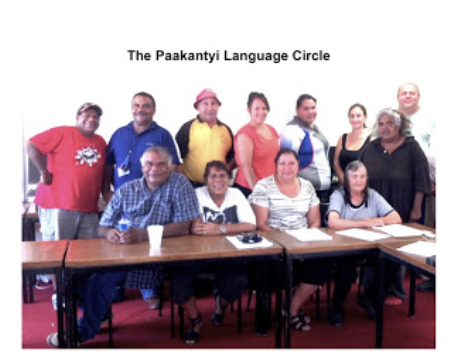
https://www.youtube.com/watch?v=B6aKm7WU4nM
Documentation: There are grammars; dictionaries; teaching and learning resources; and literature in Paakantyi Palku.


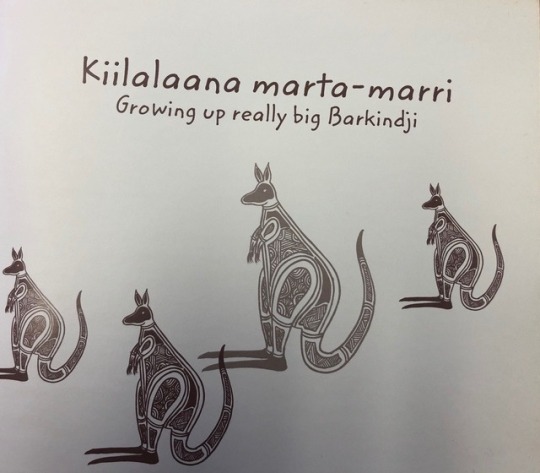
*Artwork by Uncle Badger Bates
Resources available from:
AIATSIS
Barkandji-Maraura Elders Environment Team
Maari-ma Health
Menindee Central School
Paakantyi Dictionary - Luise Hercus
Paakantyi Language Circle
University of Melbourne - Research Unit for Indigenous Language
Wilcannia Central School
Photo References:
NSW Department of Education & Training
Hope, Jeanette; Lindsay, Robert (2010). The People of the Paroo River: Frederick Bonney's Photographs (PDF). Department of Environment, Climate Change and Water, NSW. pp. 207–222.
#endangeredlanguageschallenge#endangered languages#endangered-languages#paakantyi palku#indigenous languages#aboriginal languages#paakantyi
81 notes
·
View notes
Text
Łingít
Endangered Languages Challenge 1/7

Picture source
What’s the language called?
Tlingit, Łingít. Although the name is spelled “Tlingit” in English it is actually pronounced [ˈklɪŋ.kɪt], i.e. “Klinkit”.
What linguistic family does it belong to?
It’s a Na-Dene language, related to Eyak and Athabaskan languages.
Where is it spoken?

In Alaska, it’s distributed from the mouth of the Copper River down the coast of the Gulf of Alaska, and throughout the Alexander Archipelago. There are an estimated 500 speakers there.
In Canada, Tlingit is spoken mostly in Atlin in northernmost British Columbia and Teslin in adjacent Yukon. There are a about 255 people self-identified as Tlingit speakers there.
What’s the prognosis for future transmission of the language?
Most of the remaining speakers are elderly. Speakers were stigmatized and punished for using their language for a very long time, which was a major obstacle to transmission. However, there are efforts being made to revitalize the language and create new, young speakers.
About the speaker community:
In researching the language, a recurring sentiment seems to be that the language is extremely difficult to learn for English-speakers, which can be very discouraging to a lot of potential speakers. However, there are still very determined members of the community who are tackling the challenge.
There have been language summits held to bring together community members (who are spread across several different regions) to formalize revitalization efforts, and some of the geographic communities have declared Tlingit an official language.
Does it have any official or legal status?
Short answer: It depends on where it’s spoken.
As noted above, some of the individual speaker communities have declared Tlingit an official language, but the support and protection from provincial and federal authorities in Canada is lacking. Money has been allocated for revitalization efforts for indigenous languages in British Columbia overall, but it must be divided by a number of different communities, and doesn’t go very far.
In Alaska, Tlingit (along with other languages) has been declared official by the state, but the gesture was (at the time) largely symbolic. The state has since declared that there’s a “linguistic emergency”, and the governor signed an administrative order calling for increased preservation and revitalization of indigenous languages.
Sources and resources for this post: Alaska Native Languages Center Omniglot: Tlingit Language Map of British Columbia Tlingit - The Canadian Encyclopedia Tlingit - Glottolog Tlingit - Wikipedia 'Profound gathering' aims to fuel revival of Tlingit language Budget's Indigenous languages funding 'insufficient' to support revitalization work, says B.C. advocate Preserving the Arctic’s indigenous languages will require all of us to work together
61 notes
·
View notes
Text
Endangered Language Challenge - Cypriot Arabic
Name(s) of the language?
The speakers call their language Σάννα (Sanna). However, it is also known as Cypriot Arabic (English), Κυπριακά αραβικά (Greek), and (Turkish).
What is it’s genealogical classification?
Sanna belongs to the Levantine grouping of the Arabic language. Arabic itself is derived from the Central Semitic branch of the Semitic languages, and that is derived from the Afro-Asiatic language family.
Sanna is sometimes considered a separate language from Arabic, but it is primarily regarded as a highly divergent dialect of Arabic, similar to the status of Maltese.
Location of the language?
Sanna is spoken in several villages of Cyprus, primarily in the North. It was mainly spoken in Kormakitis (Kurmajit/Κυρμαζ̲ιτ) but after the invasion of Northern Cyprus, the speakers fled or slowly lost their language.
Number of speakers?
The native speakers of Sanna are the Cypriot Maronites, Eastern Catholics whos ancestors came from Lebanon.
Around 140 native speakers in Northern Cyprus in 2013, but in the south, no one claimed to be a native speaker. The speakers tend to be older, but there is a school in Kormakitis that teaches Sanna.
There were 3,656 speakers in a 2011 census.
The endangerment situation
As aforementioned, the speakers are ageing, and languages like Greek, Turkish, and English are more favoured due to their use on the island.
Speech community
The speakers are working to get representation in Cyprus, and there is a school program to teach it to the children.
Official and/or legal status
The language is a recognized minority language, but it is not an official language of the country.
Documentation status
Books are being translated into the language, there is a bilingual, Sanna and Greek, dictionary, and there are grammars of the language.
Sorry its not the best addition, but I’ll get better with time! Also, if there’s anything I got wrong or missed, please let me know!
49 notes
·
View notes
Text
Endangered Langauges Challenge: Catawba
ALSO KNOWN AS: Catawaba
CLASSIFICATION: Siouan, Catawban
CODE AUTHORITY: ISO 639-3
LANGUAGE CODE: chc
LOCATION: Catawba Nation of York County, South Carolina, USA
LANGUAGE STATUS: 9 (Reawakening). Language of registered tribe: Catawba Indian Nation (Catawba Tribe of South Carolina).
LANGUAGE DEVELOPMENT: Dictionary. Catawba Nation’s Cultural Preservation Program is engaged in a language revitalization effort (Golla 2007).

This graph shows the place of Catawba within the cloud of all living languages. Each language in the world is represented by a small dot that is placed on the grid in relation to its user population (in the vertical axis) and its level of development or endangerment (in the horizontal axis), with the largest and strongest languages in the upper left and the smallest and weakest languages (down to extinction) in the lower right. The population value is the estimated number of all users (including both first and second language speakers); it is plotted on a logarithmic scale (where 100 = 1; 102 = 100; 104 = 10,000; 106 = 1,000,000; 108 = 100,000,000). The value for the development versus endangerment dimension is the estimated level on the EGIDS scale. (See the pages on Development and Endangerment for a fuller explanation.)
Catawba is represented by a large, colored dot. When the population is unknown, a color-coded question mark appears at the bottom of the grid. When there are no known users, an X appears at the bottom of the grid. The color coding matches the color scheme used in the summary profile graphs on the navigation maps for the site. In this scheme, the EGIDS levels are grouped as follows:
Red = Dying (EGIDS 8a-9) — The only fluent users (if any) are older than child-bearing age, so it is too late to restore natural intergenerational transmission through the home; a mechanism outside the home would need to be developed.
How do you pronounce the word "Catawba"? What does it mean?Catawba is pronounced "cuh-TAW-buh," and it comes from the Catawba placename Katapu, which means "fork in a river." Among themselves, the Catawba usually called themselves Ye Iswa, which means "river people." Where do the Catawbas live?The Catawbas are original residents of North and South Carolina. Most Catawba people still live in South Carolina today, although others were forced to move to Oklahoma along with the Cherokees in the 1800's. How is the Catawba Indian nation organized? The Catawba tribe has a reservation, which is land that belongs to them and is legally under their control. The Catawbas have their own government, laws, police, and other services, just like a small country. However, the Catawbas are also US citizens and must obey American law. In the past, the Catawba tribe was ruled by a chief from a leading clan. Today, the Catawbas are governed by a tribal council whose members are elected. What language do the Catawbas speak? The Catawba people speak English today. In the past, they spoke their native Catawba language. Unfortunately, no Catawba Indian people are fluent in this language anymore. However, some Catawbas are working to learn to speak their language again. If you'd like to know an easy Catawba word, hawoh (pronounced hah-woh) means 'thank you.' You can also read this picture glossary of Catawba Indian words. What was Catawba culture like in the past? What is it like now? Here is a link to the home page of the Catawba Cultural Preservation Project, where you can learn about the Catawba Indians past and present.
#linguistics#endangered-languages#sociolinguistics#ethnography#endangeredlanguageschallenge#catawba#language
35 notes
·
View notes
Text
Endangered Languages Challenge - Master list 1

Thank you for everyone who participated, especially the authors!
I am delighted to see that so many of you liked and reblogged the entries.
Here’s a list of all the contributions I am currently aware of:
by @turtleisland-languages
Oneida
by @dystonia-linguist
Mansi
Mising
by @helleniclanguageboy
Cypriot Arabic
Cypriot Arabic - Sanna
by @languageoficeandfire
Carib
Aleut
by @perkeleet-paassani
Chuvash
Manchu
Komo
by @siancore
Paakantyi Palku
Ngiyampaa
Gamilaraay
by @practicingtheliberalarts
Catawba 1
Catawba 2
Catawba 3
Catawba 4
Catawba 5
Catawba 6
by @phonaesthemes
Łingít
Udi
Malecite & Mi’kmaq
Canadian Gaelic
Tłıchǫ Yatıì
Tiéfo
by @injerabae
Ongota
Kujargé
Argobba
Sirzakwai
Láàl
Aasáx
by @languagesandshootingstars
Ainu
Livonian
Yukaghir
Yeyi
Chipewyan
Tehuelche
Palawa Kani
by @linguisten
Dyirbal
Resígaro
Livonian
Yurok
Uma’ Lung
Takuu
Yaghan
#endangeredlanguageschallenge#lingblr#linguistics#endangered languages#sociolinguistics#language documentation
135 notes
·
View notes
Text
Endangered languages challenge: 1/7, Chuvash

Names of the language:
The language is called Чăвашла or Чăваш чĕлхи in the language itself, Чувашский язык in Russian, and Chuvash in English.
Genealogical affiliation:
Chuvash is a Turkic language, and is classified as the only remaining member of the Oghuric branch of Turkic languages. This means it is mutually unintelligible with any other Turkic language.
Location of the language:
Chuvash is spoken in the Chuvash republic (aka Chuvashia) in the centre of European Russia, on the bank of the Volga river. Number of speakers: According to a 2010 census, there are 1,042,989 native speakers of Chuvash within Chuvashia itself, and another 34,000 Chuvash speakers abroad (one of whom works in my university in fact). There are a reported 200,000 L2 users. In a 2002 census, 86% of ethnic Chuvash and 8% of the people of other ethnicities living in Chuvashia claimed knowledge of Chuvash language .
Endangerment situation:
Chuvash is considered endangered by UNESCO. The EGIDS level of Chuvash is 6b (Threatened) - The language is used for face-to-face communication within all generations, but it is losing users. It holds the status of statutory provincial language in Chuvash Republic (1937, Constitution of the Chuvash Republic, Article 8). Chuvash became endangered due to the general Russification of the whole country, with Peter the great pushing education in Russian and limiting career opportunities for non-russian nations, and as a result the Chuvash elite disappeared. Today, Chuvash is taught as a compulsory subject in schools for everyone in the area, but due to the fact Russian dominates in most spheres of life, Chuvash is falling out of use and many children are unlikely to become active users of the language. However, Chuvash still enjoys a rich literary body even today, and according to the Index Translationum by UNESCO, at least 202 books translated from Chuvash were published in other languages since 1979
Official/legal status:
Chuvash is recognised as an official minority language in the Russian federation and holds constitutional status within the Chuvash republic itself. In order to become the president of Chuvashia, it is a constitutional requirement to be fluent enough in Chuvash to comfortably give public addresses. Documentation status:
Chuvash is incredibly well documented, with full grammars and free courses available online. The Chuvash state produced a TV series to help children and young people learn the language, and it is taught in schools as a compulsory subject. Chuvash literature is still heavily published. Sources Wikipedia Unesco: Index Translatorium with translations published since the fall of the soviet union Ethnologue Also I just know speakers and people from the area so y’know, I talked to them about it. Not exactly a rigorous academic citation but hey, this is a tumblr post.
#endangered languages challenge#Chuvash#Languages#Language#Langblr#Endangered languages#Languages of Russia#endangeredlanguageschallenge
78 notes
·
View notes
Photo

Endangered Languages Challenge: Ngiyampaa
Name: Ngiyampaa also Ngiyambaa; Ngiamba; Ngaiamba; Nyamba; Ngiumba; Gaiamba; Ngemba; Ngeumba (Parrintyi by Paakantyi neighbours)
Genealogical Affiliation: Pama-Nyungan
Main Dialects: Wanggay (’no’) or Wanggaybuwan - spoken in the south
Wayil or Wayilwan - spoken in the north
Location: Central New South Wales, Australia. Bourke; Cobar; Nyngan; Ivanhoe; Willandra Creek; Bogan RIver.

Number of Speakers: The National Indigenous Languages Survey 2005 Report estimated 2 speakers of Ngiyampaa. These are low as most Aboriginal people do not like to give information freely because of unethical practices by anthropologists and linguists in the past.
Why is the language endangered? Step 2 of Process of Colonisation as outlined by Prof Virgilio Enriques: Destruction/Eradication. The forced removal from families, and the dispossession of many Ngiyampaa people contributed greatly to the destruction of the Ngiyampaa language. Many families were rounded up from areas around Cobar, Hillston, and Ivanhoe, and driven by the truckloads to Missions in Victoria (Yelta) and Menindee. There was widespread destruction of kinship links, and ties to Country that exacerbated the disintegration of the language. This was a targeted effort as part of Australian government policies of assimilation and cultural genocide of Indigenous populations.
Speaker Group:
Artwork of Mullian (wedge-tailed eagle) by Millmullian the Artist
Eric Avery is a Ngiyampaa violinist and Language Knowledge Holder
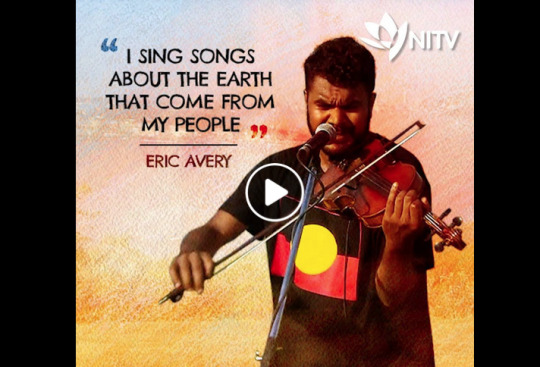
https://www.facebook.com/NITVAustralia/videos/367590474067450/
The Kelly/Pappin family are spokespeople for the Ngiyampaa people in cultural and linguistic conservation, as well as Native Title and Land Rights
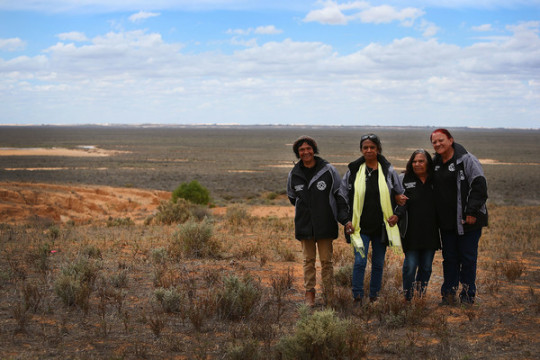
Vitality & transmission: According to AUSTLANG, Ngiyampaa is “no longer fully spoken” (endangerment grade 0).
Media/Literature/Instruction: Joining The Dreaming Aboriginal Corporation at Broken Hill is developing language kits with posters, workbooks and DVDs (2007).

(My great-grandfather Dave Harris is singing and telling stories in Ngiyampaa on this cassette recording)
Word List in the Macquarie Aboriginal Words Dictionary
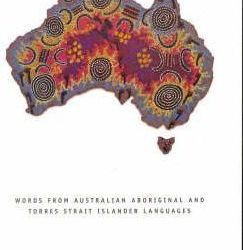
References:
Donaldson, Tamsin. 1978. Interim dictionary of Ngiyambaa of the Wangaaybuwan.
Donaldson, Tamsin. 1980. Ngiyambaa: the language of the Wangaaybuwan. Cambridge: Cambridge University Press.
#endangeredlanguageschallenge#endangered-languages#ngiyampaa#indigenous languages#aboriginal languages
67 notes
·
View notes
Text
Tiéfo
Endangered Languages Challenge 6/7

What’s the language called?
Tiéfo, Cɛfɔ, Foro, Tyefo, Tyeforo, Kiefo, Tiefo
What linguistic family does it belong to?
Niger-Congo, Atlantic-Congo, North Volta-Congo, Gur. There are two related but mutually unintelligible languages: Tiefo-N (for Nyafogo where it’s spoken) and Tiefo-D (for Daramandougou where it’s spoken). They’re apparently Gur languages but their relation to any other languages is unclear.
Where is it spoken?
Burkina Faso, in the northern Comoe and southern Houet Provinces.

What’s the situation for the language and speaker community?
It seems to depend on the individual geographic community.
Along with the language, Tiefo culture overall is considered to be endangered. Many of the Tiefo now speak Dyula and learn French in school, and aren’t necessarily passing on the Tiefo language to younger generations.

"It is said that the Tiéfo are endangered, because a people without language is an unarmed soldier. Otherwise we are there but as we do not understand our language, that's why we say we are endangered.” - Felix Ouattara (pictured above)
In a 2001 sociolinguistic report on Tiefo, in Dramandougou specifically, six of ten of the respondents stated that young people speak Tiéfo most of the time, and that children speak it with each other, which seems encouraging. However, it’s not the language used in education (which is either Dyula or French), which limits the contexts in which they will be able to use Tiefo later on in life. Adults speak the language with each other, but can’t get by without speaking at least some Dyula.
The report also mentions that the Tiefo in Dramandougou have very strong feelings about their language, and are very concerned about its endangerment. Respondents indicated that they’d prefer to have the option to learn to read and write in Tiefo, and they unanimously agreed that traditional ceremonies and stories are best in Tiefo.
Does it have any official or legal status?
Not as far as I’ve found. French is the official language, and Mossi/Móorè, Dyula, and Fulfulde are considered national languages in Burkina Faso.
What’s its documentation status?
Tiefo’s grammar has been documented, but mainly by outsiders. I wasn’t able to find whether there are teaching materials in the language or whether speakers have access to resources in their language. Given everything else I read, it seems unlikely, though.
Sources and resources: https://www.sil.org/system/files/reapdata/67/27/48/67274852587554948301483132302180825127/SILESR2002_006.pdf http://www.endangeredlanguages.com/lang/3818 https://en.wikipedia.org/wiki/Tyefo_language https://joshuaproject.net/assets/media/profiles/text/t15477.pdf https://dogonlanguages.org/other#tiefo http://www.fasozine.com/actualite/culture/3810-le-peuple-tiefo-un-groupe-ethnique-en-voie-de-disparition-au-burkina.html https://www.burkina24.com/2018/04/11/le-tiefo-une-identite-culturelle-en-peril/ http://burkina.cascades.over-blog.com/article-le-village-de-dramandougou-dernier-locuteur-de-la-langue-tiefou-72165635.html
58 notes
·
View notes
Photo
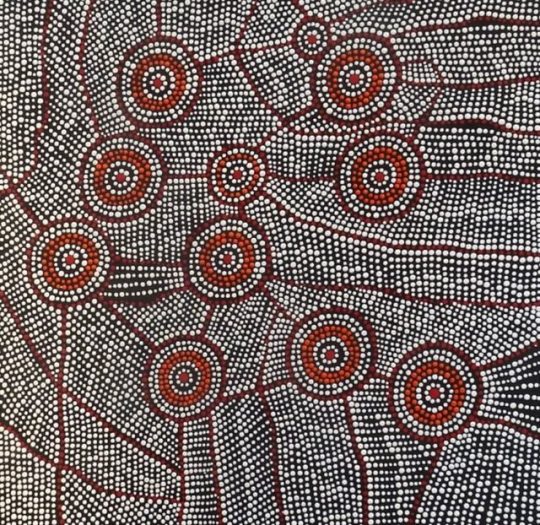
Endangered Languages Challenge: Gamilaraay/Yuwaalaraay/Yuwaalayaay
Name: Gamilaraay also Goomeroi; Kamilaroi; Gamilaroi
Genealogical Affiliation: Pama-Nyungan
Dialects: Yuwaalaraay; Yuwaaliyaay (Euahlayi); Gunjbaraay; Gawambaraay; Wirray Wirray (Wiriwiri); Walaraay
Location: Central-Northern New South Wales, Australia
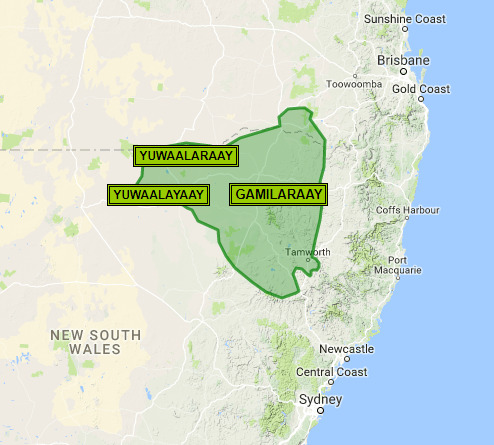
Number of Speakers: 105 with revitalisation efforts
Why is the language endangered? Due to negative impacts of colonisation, especially in central NSW where there was frequent frontier violence at contact and large numbers of Aboriginal children forcibly removed from families, thus severing kinship ties and connection to communities. Alongside dispossession of land, and Australian government policies of assimilation and systemic cultural genocide.
Speaker Group: Members of the Gamilaraay Nation have proactively been involved in language maintenance and revitalisation efforts for a number of years. yuwaalaraay.com is a website that speakers and Language Knowledge Holders have created. It has an extensive collection of resources for language education. Gamilaraay is taught in schools and TAFE.

Media/Literature/Instruction:
There’s a Gamilaraay Dictionary that was published. It is available as an electronic resource as well (below is the copy a mate of mine, a Gamilaraay woman, gave me many years ago):
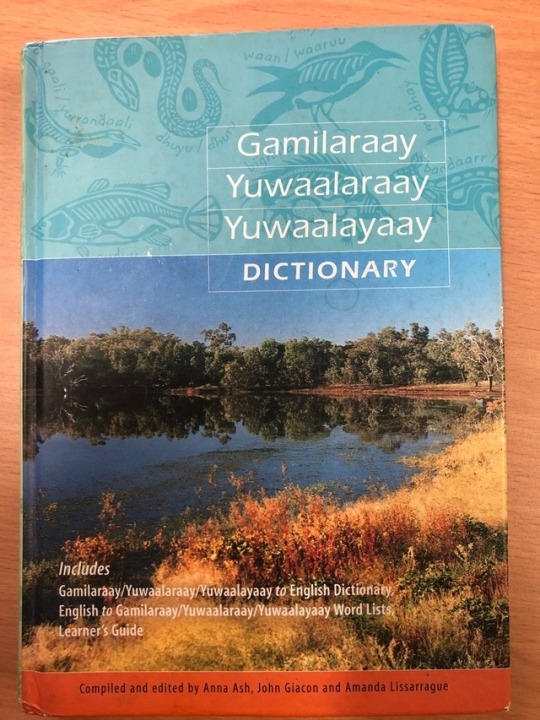
There are a number of children’s books written in Gamilaraay/Yuwaalaraay/Yuwaalayaa


Artwork by Arkeria Rose Armstrong
References and Resources:
Ash, A., Giacon, J. and Lissarrague, A. eds., 2003. Gamilaraay, Yuwaalaraay & Yuwaalayaay dictionary. IAD Press.
Austin, P., 1993. A REFERENCE GRAMMAR OF GAMILARAAY, NORTHERN NEW SOUTH WALES.
Five Senses Education
https://yuwaalaraay.com/online-resources/
#endangeredlanguageschallenge#endangered-languages#endangered languages#gamilaraay#aboriginal languages#indigenous languages
48 notes
·
View notes
Text
Udi
Endangered Languages Challenge 2/7
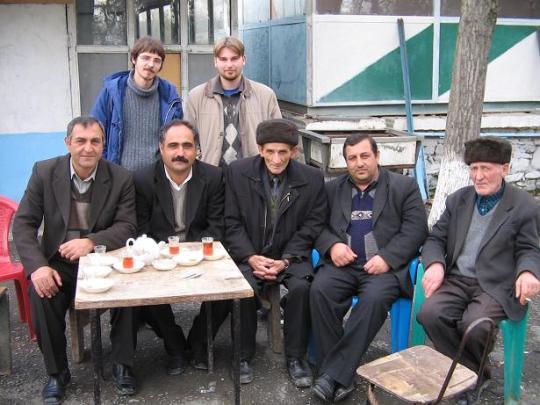
What’s the language called?
Udi, удин муз, Udin muz
What linguistic family does it belong to?
Udi is a Lezgic language, and it’s related to Lezgian, Aghul, Kryts, Tabasaran, Budukh, Rutul, and Tsakhur.
Where is it spoken?
In Azerbaijan, it’s spoken in Qabala rayon (specifically in a town called Nij) and in Oghuz rayon, and speakers are also found in North Caucasus in Russia. It is also spoken by ethnic Udis living in the villages of Debetavan, Bagratashen, Ptghavan, and Haghtanak in Armenia and in Zinobiani in Georgia.

What’s the situation for the community of speakers?
There are estimated to be about 10,000 Udi people, but fewer speakers of the language. UNESCO classifies the Udi language as “severely endangered”.
Udi people live in various places in Azerbaijan, Russia, Armenia, Georgia, and elsewhere, but there are few concentrated communities of Udi speakers, which poses a challenge for transmission of the language.
The sociolinguistic situation is further complicated by strife between Armenia and Azerbaijan; the countries went to war in the late 80s, and many Udis either fled or were forced out of the regions where they had been living previously. In some cases, they ended up bolstering the Udi-speaking populations in other areas, but many others ended up in diaspora.
In predominantly-Udi town of Nij in Azerbaijan, the language is taught to children in elementary schools since the 90s and there are books available in the language (at least, according to one source; others I found indicate otherwise.) However, Udi children living elsewhere are educated in the majority languages of whatever region they happen to live. The younger the Udi person, the less likely they are to speak the language.
In the town of Zinobiani in Georgia, one of the schools houses a museum dedicated to the Udi language.
Udi is still the language of daily life for many in the community, but for official or employment purposes, many must be bi- or multilingual in a majority language such as Azeri, Russian, Armenian, or Georgian.
In Nij at least, at least one study indicates that speakers view their language positively: “Over two-thirds of respondents indicated they use Udi in the work-place. Udi is the language of the home and the village. Respondents unanimously said that mothers should speak Udi to their children and that children should learn Udi before Russian or Azerbaijani.”
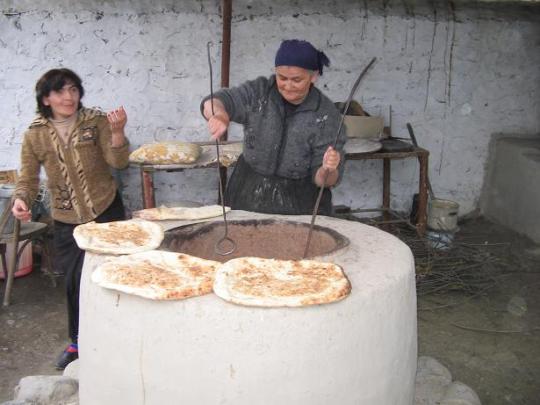
Does it have any official or legal status?
It’s not an official language of any of the countries in which it’s spoken. Azerbaijan recognizes and has taken some interest in maintaining/protecting Udi culture because of its role in the country’s history, and educational and language-learning materials have been created for the Udi language.
Sources and resources:
A team from the Russian Academy of Science documented their trips to Udi villages - (Russian Language, but there are lots of pictures) Articles on Udi, available for download - (Russian language) Udi people - Wikipedia Udi language - Wikipedia Udi language - Omniglot Caucauscapades - A team documents their trip to the Georgian Udi village of Zinobiani Svan/Udi/Sova-Tush - http://dobes.mpi.nl/projects/svan/language/ -DOBES Towards a History of Udi - Wolfgang Schulze Colonialism, nationalism and language vitality in Azerbaijan
#udi#удин муз#endangered-languages#endangeredlanguageschallenge#this was one of my favourites to learn about
45 notes
·
View notes
Text
Tłıchǫ Yatıì
Endangered Languages Challenge 5/7

What’s the language called?
Dogrib or Tłıchǫ Yatıì
What linguistic family does it belong to?
It’s a Northern Athabaskan language, related to languages such as Dene Suline, Gwich'in, and Slavey.
Where is it spoken?

In the Northwest Territories in Canada, east of the Mackenzie River between Great Slave Lake and Great Bear Lake, in four primary communities: Gamètì, Behchokǫ̀,, Wekweètì, and Whatì, as well as in Yellowknife and Dettah.
What’s the current situation? As of 2011, StatsCan reported 2,080 speakers, a decrease from earlier years. It’s believed that only 53% of Tlicho aged 15-24 speak the language, compared to 94% of those over 60.
Although the language is much less threatened than many others, there are still significant community efforts to ensure that it will be maintained and passed on to future generations.
For instance, they’ve established the Dedats'eetsaa, or Tłı̨chǫ Research and Training Institute to “advance the study of Tłı̨chǫ lands, language, culture and way of life through research, training, education and monitoring.”
The Tlicho government is also committed to preserving and promoting their traditional way of life, including the use of the language. One way of doing this is through the Tłı̨chǫ Įmbè program, which matches young community members with elders in order to learn cultural practices alongside Tłıchǫ Yatıì.
There’s also a multimedia dictionary available online, which includes audio samples, as well as the Tłı̨chǫ Digital Archives, which include audio, video, and text samples of the language, as well as information about the history and the culture of the speakers.

Does it have any official or legal status?
Indigenous languages, such as Tlicho, are supposed to be legally protected in the Northwest Territories, but in actual fact, not all services are available to speakers.
Sources and resources: Dogrib - Wikipedia Tlicho Government - Cultural Practices Tlicho multimedia dictionary Omniglot - Tlicho Glottolog - Tlicho Dedats’eetsaa Tlicho Research and Training Institute Tlicho region looks to bridge language gap between youth, elders Diga Speaks Tlicho - First Words
43 notes
·
View notes
Text
Malecite
Malecite - Endangered Languages Challenge 3b/7 (Since Malecite and Mi’kmaq are related, I wanted to post them both for day 3.)

Picture source What’s the language called?
Malecite/Maliseet-Passamaquoddy in English, and Wolastoqey in the language itself.
What linguistic family does it belong to?
It’s an Eastern Algonquian language, related to Mi’kmaq and Abenaki.
Where is it spoken?
Mostly in what is now New Brunswick, Canada (specifically Tobique, Woodstock, Kingsclear, St. Mary’s, and Oromocto), and Maine in the US (Pleasant Point and Indian Township specifically).
What’s the situation?
It’s estimated to have 400-600 speakers (mostly in Canada), mostly over the age of 50. The continuing effects of Canada’s indigenous genocide and the lack of transmission to new, young speakers are major obstacles right now, but there are ongoing revitalization and maintenance efforts.
About the speaker community:
The speakers were discouraged or outright punished for using their language for many years (for instance, in residential schools), but there’s been significant interest in bringing back the use of the language into daily life.
The Language Keepers project went about recording speakers while they had natural conversations with each other at gatherings (as opposed to elicitation). The videos and the dictionary that was compiled have reportedly been popular and encouraging to the larger community, helping older speakers feel more comfortable using the language again, and sparking interest in younger community members who may want to learn the language themselves.

Does it have any official or legal status?
Not really. Like other indigenous languages in Canada, there has been some funding offered for revitalization efforts, but there’s very little official or legal support for the language.
What’s its documentation status?
It’s quite well-documented. Bilingual dictionaries have also been compiled and are available online, with many entries offering audio samples of the language as well.
Sources and resources: The Passamaquoddy-Maliseet Dictionary The Language Keepers Project REVIVING PASSAMAQUODDY: A COMMUNITY FINDS HEALING THROUGH ITS OWN LANGUAGE Malecite - Wikipedia Malecite - Ethnologue Maliseet - ELP Passamaquoddy Tribe Looking to Children to Preserve Language As native speakers decline, Indigenous languages fight for survival
41 notes
·
View notes
Text
Endangered languages challenge, 3/7, Komo

Names of the language:
The language has several names, such as Go-kwom, Tta komo, Madiin, Koma, South Koma, Central Koma, Gokwom and Hayahaya, but the most common term is simply “Komo”. Genealogical affiliation:
Komo is a member of the Koman branch of the Komuz language family. It is also thought to be a member of the controversial Nilo-saharan family. Other relations are Uduk, Opuo, Gwama and Gule (which is thought to be extinct). Also it’s thought Komo may be a dialect of Gwama (even though they are not mutually intelligible and only share 30% cognates) because they don’t know if “Kwama” is the Gwama word for Komo or another word for Gwama and they haven’t done any research about it. Some linguists are also trying to prove a link between Koman languages and the Gumuz languages.
Location of the language:
Komo is the ethnic language of the Kwama people of Ethiopia, Sudan and south Sudan.In Ethiopia, the majority of speakers live in the Benishangul-Gumuz region, in the Mao-Komo special woreda, with some speakers living in the Gambela region too. In Sudan it is mostly located in the An Nil al Azraq region, and in south Sudan, it is found in the Upper Nile state. Number of speakers: The big problem with estimating the number of Komo speakers is that the censuses don’t seem to care about it all that much. The 2007 census made no mention of it at all, so we only have an estimate from that year. Endangerment situation:
UNESCO classififes Komo as “definitely endangered, but ethnologue places it at 6a (vigorous) in Sudan and south Sudan, meaning the language is still seeing use in all spheres of life by all ages. In Ethiopia however, it is classified as 6b (threatened). In 1979 it was estimated that there were around 10,000 speakers, which in 2007 was estimated to be at around 8,500 speakers. Many Komo people are illiterate, but an orthography has been decided and writing workshops are held to teach people to read and write. In Ethiopia, it has been taught in primary schools as a subject from grade 1 since 2013. Official/legal status:
Komo does not seem to hold any official status, to the point of being barely mentioned in Ethiopian censuses. (Censi?). However the Komo language is considered a prestige language in the region, and ethnic group does have a right to receive an education in Komo in their region in Ethiopia, thanks to multilingual education initiatives, even if Amharic is the default language of education in the region. Documentation status:
Komo is very underresearched- it is unsure what language family it even belongs to. Lots of the studies even contradict each other, so if this reads very self-contradictorarily, that’s why. Many Komo children receive education in Komo and an orthography has been conclusively decided, so Komo as a language is reasonably well documented, and researchers are still in the process of discovering more about it. Sources Wikipedia Omniglot Ethnologue A sample of spoken Komo, it’s some religious thing because of course it would be I’ll be honest @injerabae (huge shoutout to him, he’s an inspiration, and if you’re interested in african linguistics he’s definitely one to follow) can explain the whole classification thing way better than me, in his words Nilo-Saharan is kind of like “Africanist Altaic” so I’d take that part about it being Nilo-saharan with a pinch of salt. Also, many thanks to him for corrections and clarifications on this too.
#endangered languages challenge#endangeredlanguageschallenge#Endangered languages#komo#languages of ethiopia
35 notes
·
View notes
Text
Endangered Languages Challenge: Dyirbal
Endangered Languages Challenge — round 1, post 1: Dyirbal
name(s) of the language Dyirbal, Jirrbal, Jirubal, Djirubal
genealogical affiliation Dyirbal is member of the Dyirbalic group of the Pama-Nyungan family
location of the language Cape York peninsula, Queensland, Australia
number of speakers Depending on the source, between 0 (census 2006), 3 (Dixon, p.c., 1999), 8 (Census 2016) and 30 (Wikipedia); vertical transmission has been interrupted and fragile since at least the 1930s; speaker numbers have been projected to decline since the 1970s
endangerment situation The speaker community has been disrupted by colonialism and politics of Australia for most of the past 200 years; the Dyirbalngan would not have full human and citizenship rights until rather recently, they were at times forced into reserves far from their ancestral lands The language is not taught in schools or used in everyday life, there are no publications or broadcasts in it either. Any kind of public or official interaction will be in English only The language is moribund
speaker community I have no recent first hand information. According to Dixon (1972) and Schmidt (1985), use of Dyirbal declined in all domains, even in the privacy of homes
language breakdown Structural collapse has been mentioned by Dixon (1972) and is the subject of Schmidt (1985): some subsystems, like the avoidance styles, have fallen out of use by the 1940s, ergativity by the 1980s; Dyirbal thus became of of the model languages for the description of this phenomenon.
official / legal status Dyirbal does not have any official status.
documentation status Dyirbal has been described by Dixon, there is a linguistic grammar with a few sample texts and a glossary; no published dictionary, no community teaching materials I am aware of; Dixon’s field recordings etc. are archived at AIATSIS [see a discussion on that]: Word list Medium (100-200 pages) Text Collection Medium (100-200 pages) Grammar Large grammar (more than 200 pages) Audio-visual More than 10
Sources:
Dixon, R. M. W.: The Dyirbal language of north Queensland. Cambridge: Cambridge University Press, 1972.
Schmidt, A: Young People's Dyirbal: An Example of Language Death from Australia. Cambridge: Cambridge University Press, 1985.
AIATSIS http://austlang.aiatsis.gov.au/main.php?code=Y123
#Aboriginal languages#linguistics#endangeredlanguageschallenge#endangered languages#dyirbal#Australian languages
29 notes
·
View notes